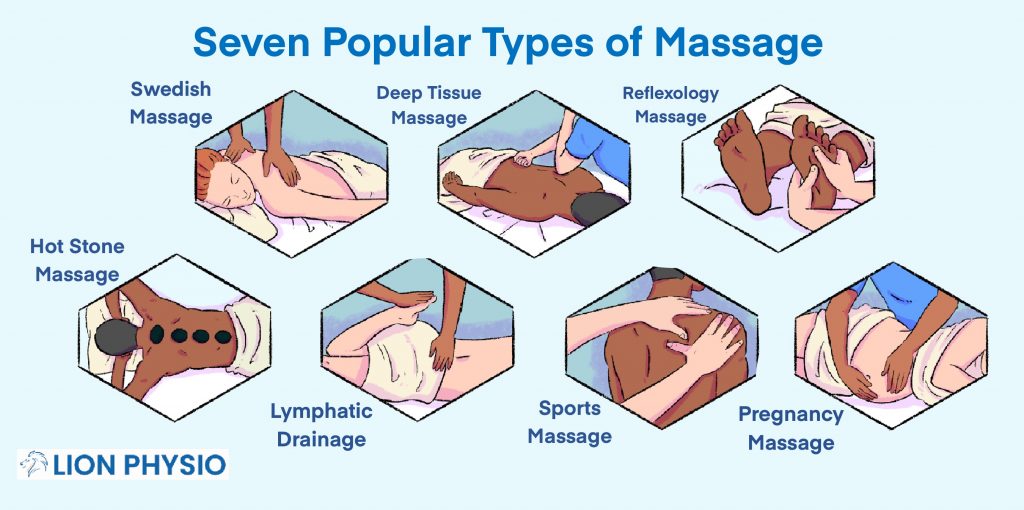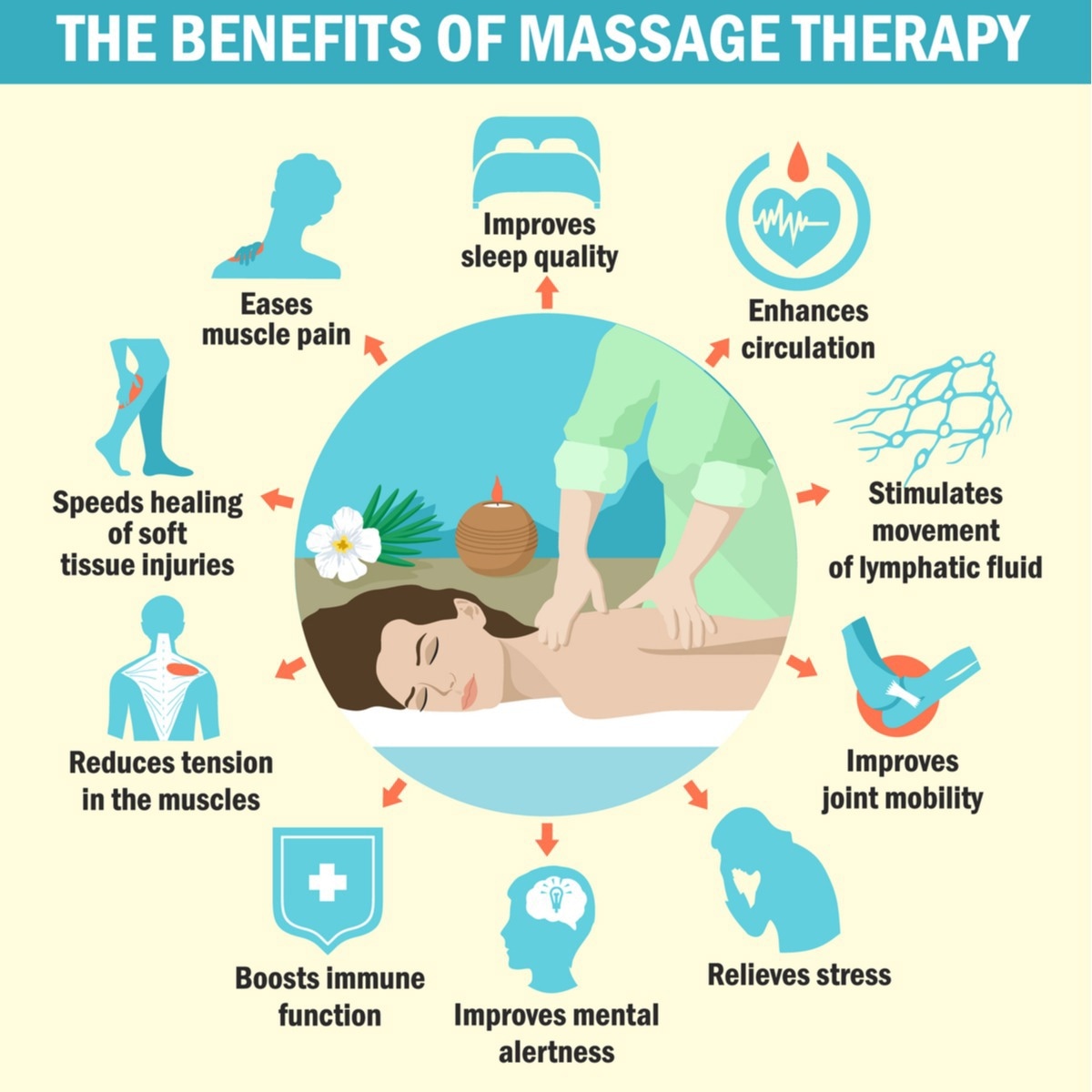During massage therapy, the therapist uses his hands, elbows, forearms or special tools to apply pressure, rub, and caress the patient's body. Before beginning a massage session, a massage therapist often conducts a thorough assessment of the patient's health to understand their needs and concerns. It helps to choose the most suitable techniques and methods that will give the best therapeutic effect.
Therapeutic massage is an integral part of a holistic approach to health that seeks to treat the entire human body, not just individual symptoms. It is a safe and effective therapy that can be combined with other treatments such as physiotherapy, chiropractic, acupuncture or medical treatment to achieve an optimal health outcome.
What are the types of therapeutic massage?
The types of therapeutic massage are diverse and are intended for specific solutions to health problems and improvement of general health. Each type of massage has its own techniques and goals and can therefore be adapted to the patient's needs and condition. Below are the main types of therapeutic massage:
- Swedish massage is one of the most common and commonly used types of massage. It involves long stroking, kneading, rubbing, tapping and vibrating movements. Swedish massage is designed to relax, reduce muscle tension, improve blood circulation and stimulate lymph circulation. This type of massage is often used as an introduction to massage therapy because it is gentle and effective.
- Deep massage is intended for the treatment of deeper layers of muscles and connective tissue. It is used to relieve chronic muscle tension and pain, especially in areas with knots or stiffness. During a deep massage, the therapist uses slower and stronger pressure movements to reach the deeper layers of the muscles. This type of massage is especially beneficial for athletes and people with chronic muscle pain.
- Sports massage is adapted to the needs of athletes and is intended to reduce the consequences of physical exertion, prevent injuries and accelerate recovery after training or competition. Sports massage includes various techniques such as deep massage, stretching, rubbing and tapping. It can be done before a competition to prepare the muscles or after to help with recovery.
- Myofascial release is a technique for reducing tension and stiffness in fascia, the thin but strong connective tissue that covers muscles, joints and other organs. In myofascial release, the therapist applies slow and steady pressure to loosen tight fascia and improve flexibility and mobility. This type of massage is beneficial for fascial strains that can cause pain and restricted movement.
- Trigger point massage focuses on the treatment of specific muscle points called "trigger points". These points are extremely sensitive and can cause pain and discomfort in other parts of the body. During a trigger point massage, the therapist applies direct pressure to these points in order to reduce their sensitivity and reduce the pain caused. This type of massage is effective in treating chronic pain and muscle spasms.
- Reflexology is a type of massage that focuses on specific areas of the feet, hands or ears that are believed to correspond to certain body parts and organs. The purpose of reflexology is to promote healing and health balance in the body by stimulating these reflex points. This type of massage can help reduce stress, improve circulation and promote general well-being.
- Lymphatic drainage massage is a gentle massage technique designed to stimulate lymph circulation and remove excess fluid from body tissues. During a lymphatic drainage massage, the therapist uses gentle, rhythmic movements to help the lymph move more easily through the lymph channels and nodes. This type of massage is especially useful after operations, in case of edema or other conditions accompanied by fluid accumulation.
Each of these types of massage has its own advantages and can be adapted depending on the patient's health condition and needs. Therapeutic massage is not only an effective therapeutic tool, but also a holistic approach to health that aims to improve both physical and emotional well-being.

Benefits of therapeutic massage
Therapeutic massage is an ancient form of therapy that has proven its effectiveness throughout the ages in improving both physical and psychological health. Therapeutic massage uses a variety of techniques and methods to help the body recover, reduce pain and tension, and promote general well-being. Therapeutic massage not only relaxes muscles, but also has many other positive effects that can significantly improve a person's quality of life.
PHYSICAL BENEFITS
Physical benefits include improving muscle and joint health, reducing pain, improving blood and lymph circulation, and boosting the immune system. Massage helps relax muscle knots, reduces muscle tension and spasms, and increases muscle flexibility and elasticity. It is especially beneficial for people who suffer from chronic pain, back or neck problems, arthritis, fibromyalgia or other muscle and joint disorders. By improving blood circulation, massage helps to supply tissues with oxygen and nutrients, which promotes faster healing and tissue regeneration. Improving lymphatic circulation helps remove toxins and reduce edema (swelling), especially after injury or surgery. In addition, massage can increase the production of endorphins, natural pain relievers, thereby reducing the sensation of pain.
PSYCHOLOGICAL BENEFIT
The psychological benefits are no less important. Therapeutic massage can significantly reduce stress, anxiety and depression symptoms, improve sleep quality and overall emotional well-being. During massage, the level of cortisol, the stress hormone, decreases in the body, and the production of serotonin and dopamine, the feel-good hormones, increases. It helps patients feel calmer, more relaxed and happier. Regular massage can help manage chronic stress, which is linked to many health problems, including heart disease, high blood pressure, digestive problems, and a weakened immune system. Better sleep quality is also an important benefit of massage, as quality sleep is essential for physical recovery and psychological health.
In addition, massage therapy can promote awareness and better body awareness. It can help people better understand their body's needs and limits and recognize early signs of health problems. Such awareness can promote a healthier lifestyle and long-term well-being.
Thus, therapeutic massage is a powerful tool that can provide many physical and psychological benefits. Its effect is holistic, involving not only the physical body but also the emotional and psychological state. Massage therapy is an excellent complement to traditional medical treatment to help achieve optimal health and well-being.
When is therapeutic massage recommended?
Therapeutic massage is recommended in a variety of situations to relieve pain, reduce muscle tension, improve blood circulation, promote tissue healing and general health. It is useful both as a preventive measure and as part of treatment for various health conditions. Below are the main situations and health problems where therapeutic massage is especially recommended:
- Pain management and muscle tension: Therapeutic massage is an effective way to reduce various types of pain, including chronic pain, back pain, neck pain, shoulder pain, as well as headaches, migraines, and fibromyalgia symptoms. Massage helps to relax tense muscles, reduces spasms and muscle knots, which allows to reduce the sensation of pain and improve the range of motion.
- Trauma and post-operative rehabilitation: Massage is very useful after trauma or surgical interventions. It helps tissue repair faster, reduces swelling and fluid retention, improves scar elasticity and reduces scar tissue formation. It also stimulates blood circulation, which speeds up the healing process and helps you return to normal activity faster.
- Sports activities and physical overload: For athletes and people who promote an active lifestyle, massage helps reduce muscle tension after intense training, reduces the risk of injuries and accelerates recovery after physical exertion. Sports massage is specially tailored to the needs of athletes in order to optimize their physical condition and performance.
- Stress and psychological tension: Massage is an effective tool for reducing stress and anxiety. It helps to relax, reduces the level of cortisol (stress hormone), improves mood and emotional state. During a massage, endorphins, serotonin and dopamine are released in the body - hormones that help you feel calmer and happier. It is especially useful for people who experience high levels of stress at work or in their daily lives.
- Sleep disorders: Therapeutic massage can help with sleep problems, such as insomnia, by helping you relax and reduce anxiety. Better sleep quality is important for overall health and well-being, as quality sleep allows the body to repair itself and function properly.
- Strengthening the immune system: Massage can contribute to strengthening the immune system by stimulating lymph circulation, which helps remove toxins and other harmful metabolic products from the body. This is especially important in the cold season or when there is a higher risk of infectious diseases.
- Chronic diseases and health disorders: Therapeutic massage can be used as an adjunctive therapy for various chronic diseases such as arthritis, diabetes, hypertension and others. It helps to reduce symptoms, improves the general condition of the body and can contribute to long-term health maintenance.
- Pregnancy and postpartum: For pregnant women, massage can help reduce back and leg pain, swelling, and general discomfort associated with pregnancy. In the postpartum period, massage helps the body recover after childbirth, reduces tension and helps women feel better emotionally.

Therapeutic massage is a valuable therapeutic tool that can be applied in various situations and for various health conditions. It not only helps to solve specific health problems, but also promotes general physical and emotional well-being, which is why it is widely recommended and used in medical practice.
Information sources
- "The Science and Practice of Manual Therapy"
- "Massage Therapy: Principles and Practice"
- "Trigger Point Therapy for Myofascial Pain: The Practice of Informed Touch"
# gydomasis masažas

